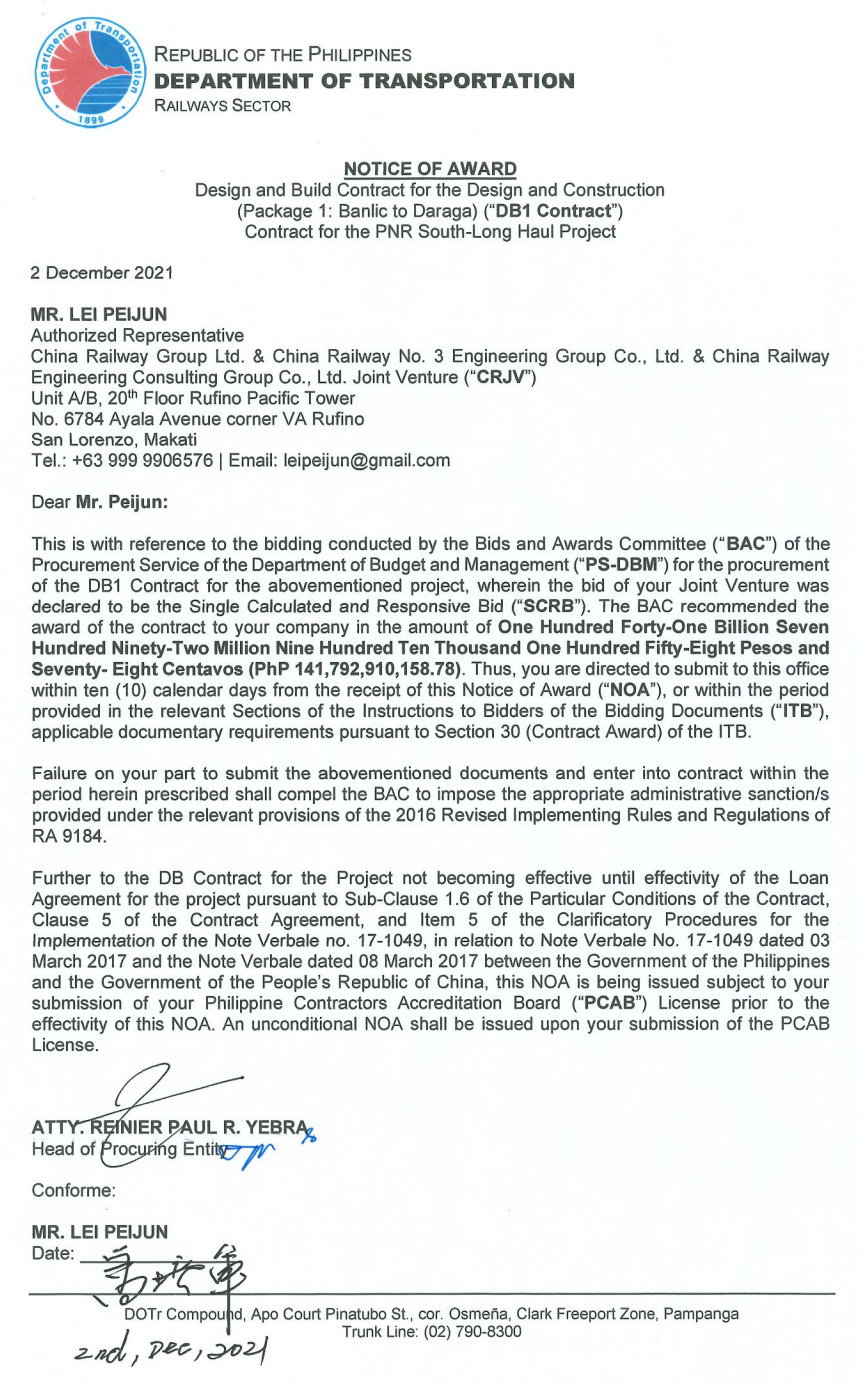In February 2020, then Socioeconomic Planning Director Ernesto M. Pernia decried the glacial pace of the Mindanao Railway project. It was a sentiment shared by congressional leaders that sought an update on the project in October 2020. Both were keenly aware that time is running out for the Duterte administration to make headway in this flagship project.
The Mindanao Railway, however, is not the only project that is running out of time. Another Chinese-backed railway project in the Philippines, the South Long-Haul Project of the Philippine National Railways (PNR), is facing a similar time-crunch. Both projects were approved by a joint Chinese-Philippine committee in a meeting in Beijing in August 2018.
A study into the challenges faced by the Bicol-to-NCR line -- which leverages an already-existing right-of-way -- will put the delays faced by the all-new-from-the-ground-up Tagum-Davao-Digos system into better perspective.
This article has been divided into the following sections:
The southbound rail
The PNR South Long Haul Project will link the PNR main station in Tutuban, Manila to Matong, Sorsogon in Bicol. The DOTr bid invitation for this project provides an overview of the project.
The Republic of the Philippines Department of Transportation, pursuant to the applicable executive agreements between the Government of the Philippines and the Government of the People’s Republic of China (GPH-GPRC Executive Agreements) intends to apply the sum of PhP14,393,505,005.08 being the Approved Budget for the Contract (ABC) to payments under the contract for the Project Management Consultancy of the Philippine National Railways South Long Haul Project (North South Railway Project). Bids received in excess of the ABC shall be automatically rejected at bid opening.
The Republic of the Philippines Department of Transportation now invites bids for Project Management Consultant (PMC) for PNR South Long Haul Project. Completion of the Works is required within approximately seven (7) years. Bidders should have completed a contract similar to the Project. The description of an eligible bidder is contained in the Bidding Documents, particularly, in Section II. Instructions to Bidders.
The railway will maximize the existing southbound PNR right-of-way (ROW), and will even share it with the Japan-funded North-South Commuter Railway (NSCR) up to the Laguna leg of the line. But at key points on the ROW, it will reportedly acquire additional rights-of-way to improve system efficiency.
The PNR Website featured the following diagram of the original railway in Bicol. Based on pronouncement by PNR General Manager Junn Magno, some of these stations will be bypassed as part of the railway improvement.
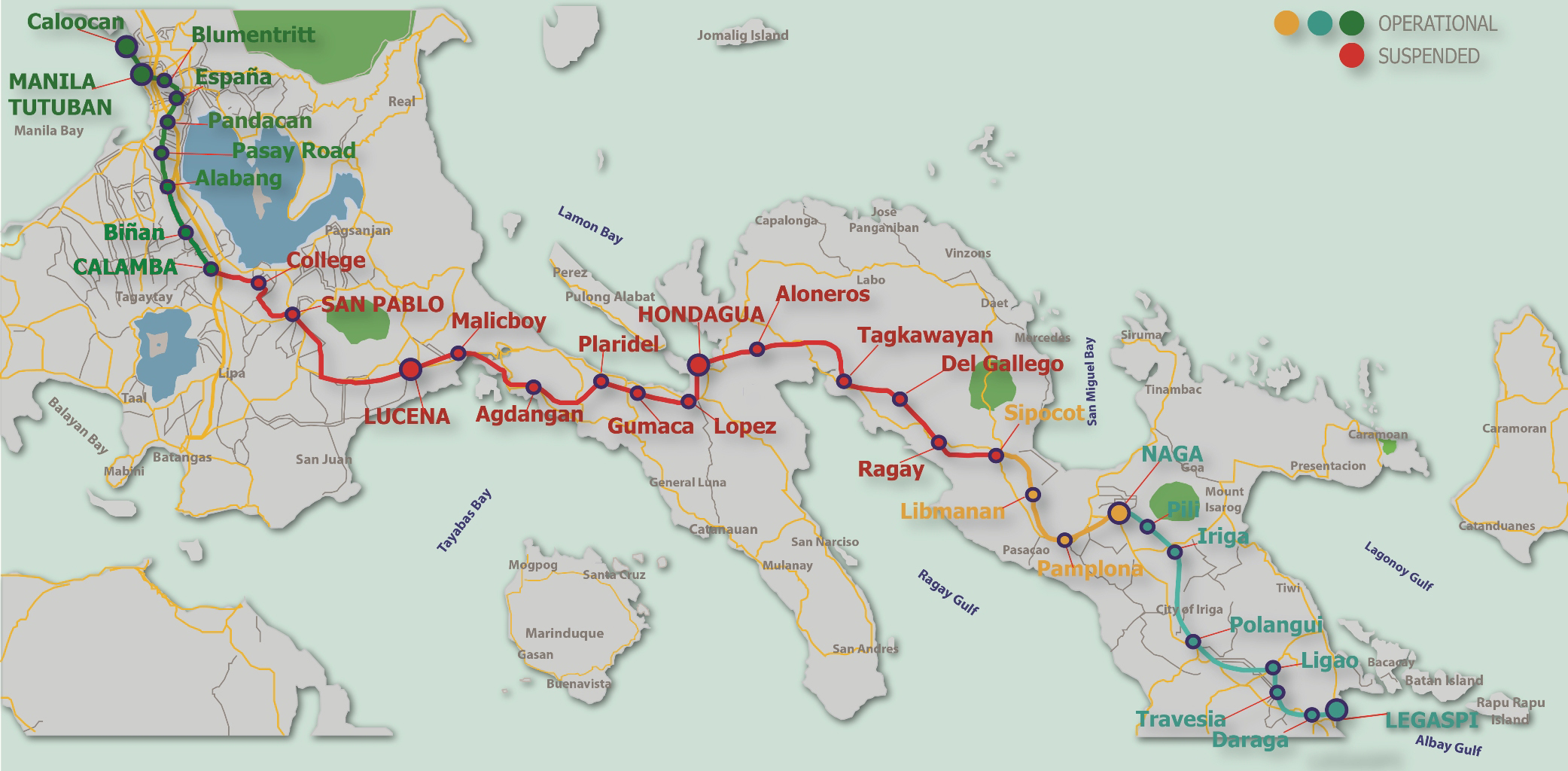
The map prepared by winning bidder for the project, and made available on the Department of Finance website, appears below.
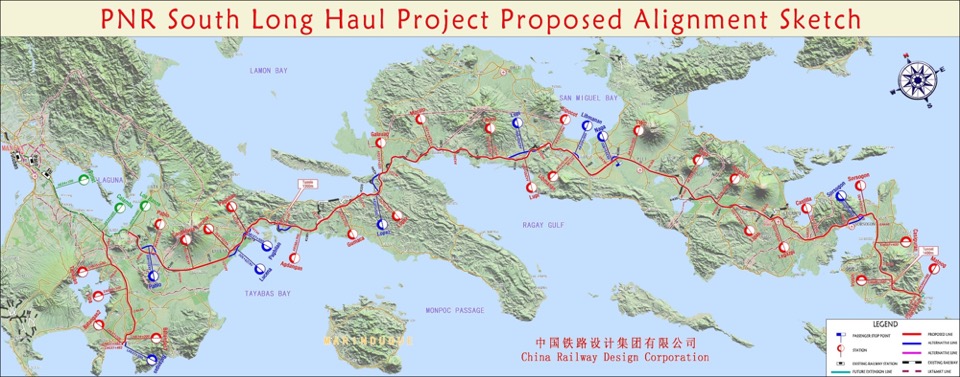
The project is expected to be divided into the following segments (as per DOTr Reference No. PB18-237-8):
- Segment A is from Manila to Naga, Camarines Sur
- Segment B is from Naga to Legazpi, Albay
- Segment C is from Legazpi to Matong, Sorsogon
- Segment D is from Calamba, Laguna to Batangas Port, Batangas
The DOTr issued the following press release, in 21 November 2018, to announce the signing of the contract for Project Management Consultancy Services for the South Long-Haul Project. The release summarized key points of the project.
MAKATI CITY – The Philippines and China entered a contract for the Project Management Consultancy (PMC) of the 639-kilometer Philippine National Railways (PNR) South Long-Haul Project (a.k.a. PNR Bicol) on Saturday, 17 November 2018, at the Chinese Embassy Economic and Commercial Section at South Forbes Park in Makati City.
The contract was exchanged between Department of Transportation (DOTr) Secretary Arthur Tugade and China Railway Design Corporation (CRDC) Chairman of the Board Liu Weiqun yesterday, 20 November 2018, at Malacañang Palace, and was witnessed by Philippine President Rodrigo Duterte and Chinese President Xi Jinping.
Secretary Tugade and Undersecretary for Railways Timothy John Batan signed on behalf of the Philippine government, and CRDC Chairman of the Board Liu Weiqun for the CRDC and Guangzhou Wanan Construction Supervision Co., Ltd. (WACC) Consortium of the People’s Republic of China.
The contract signing was witnessed by Economic and Commercial Counselor of the Chinese Embassy to the Philippines Jin Yuan, DOTr Undersecretary for Finance Garry De Guzman, Undersecretary for Legal Affairs Reinier Yebra, Undersecretary for Planning Ruben Reinoso, PNR General Manager Junn Magno, and CRDC Director Yang Xudong.
The National Economic and Development Authority (NEDA) Board previously approved the financing of the PNR Bicol Project through Official Development Assistance (ODA) from the Government of China.
The PNR Bicol Project is one of the flagship projects of the Duterte Administration under the “Build, Build, Build” Program. Upon completion, the PNR Bicol Project will connect Metro Manila, Region IV-A (Calabarzon), and Region V (Bicol), reducing travel time from Manila to Legazpi City from 13 hours to under 6 hours.
< Edited >
For the PNR Bicol Project, the CRDC-WACC Consortium will conduct all pre-construction surveys (topographic, geotechnical, hydrological, parcellary, environmental, etc.), preparation of designs for bidding, preparation of bidding documents, bidding assistance, construction supervision, and defects liability period (warranty) supervision.
< Edited >
One of the key points in the press release was the rationale for the selection of Chinese consortium as general contractor.
As with other ODA-financed projects, the DOTr engaged a PMC (also called a General Consultant) to provide consultancy services on technical and commercial matters concerning a project. Being a China ODA-financed contract, the selection of the PMC was based on a list of qualified and experienced bidders, as endorsed by the Chinese government.
Given prevailing tensions with China, Chinese involvement in the project has raised concerns. Based on recent experience with Northrail, these concerns are not devoid of merit.
The credit facility
The Department of Finance (DOF) published details of the credit agreement on its Website on September 16, 2019. The document is available here and opened with the following self-description -- which also indicated the start of the agreement.
THIS PREFERRENTIAL BUYER’S CREDIT LOAN AGREEMENT (hereinafter referred to as this “Agreement”) is made on the 29th day of August 2019 between:
THE GOVERNMENT OF THE REPUBLIC OF THE PHILIPPINES, acting by and through the Department of Finance (DOF) (hereinafter referred to as the “Borrower”) . . .; and
THE EXPORT-IMPORT BANK OF CHINA (hereinafter referred to as the “Lender”)
Details of the loan were revealed in Article 2 of the document.
Article 2 Conditions and Utilization of the Facility
2.1 Amount. Subject to the terms of conditions of this Agreement, the Lender hereby agrees to make available to the Borrower a loan facility (hereinafter referred to as the "Facility") in an aggregate principal amount not exceeding Two Hundred Nineteen Million, Seven Hundred Seventy-Six Thousand, Two Hundred Forty-Two and Sixty Three Cents US Dollar (US$ 219,776,242.63).
2.2 Interest rate. The rate of interest applicable to the Loan shall be two percent (2%) per annum.
2.3 Maturity Period. The Maturity Period for the Facility shall be twenty (20) years commending from the Effective Date, wherein the Grace Period shall be seven (7) years and the Repayment Period shall be thirteen (13) years.
2.4 Purpose. The entire proceeds of the Facility shall be applied by the Borrower for the sole purpose of the payment up to eighty-one percent (81%) of the Consultancy Contract Amount, and not be used for payment of brokerage fees, agency fees or commission.
In addition to the loan repayment, the Export-Import Bank of China will receive a management fee in the aggregate amount of US$659,328.73.
The facility will be divided into the following four tranches:
| Tranche | Year covered | Amount in USD | Amount in PHP equivalent |
| 1 | 2019 - 2020 | 68,043,275.33 | 3,606,293,592.52 |
| 2 | 2021 - 2022 | 99,333,958.50 | 5,264,699,800.51 |
| 3 | 2023 - 2024 | 39,341,504.56 | 2,085,099,741.76 |
| 4 | 2025 - end | 13,057,504.24 | 692,047,724.72 |
Article 3 of the document provides the specifics of how the funds will be made available to the DOF.
Article 3 Disbursement of the Facility
3.1 The Facility is divided into four (4) tranches respectively in the amount and covering the years as provided in Appendix 1 [Schedule of Tranches]. The Borrower may revise the amount and/or the covered years of any tranche according with the progress of the Project and accordingly update the Disbursement Schedule with the Lender not later than 90 days before the year preceding to the scheduled effective date of that upcoming tranche, to accommodate the cashflow under the Consultancy Contract. Tranches two (2) to four (4) shall automatically take effect by January 1 of the first year within the period covered by that tranche per the Disbursement Schedule or as otherwise subsequently revised by the Borrower.
3.2 The first disbursement of the first tranche is subject to the satisfaction of the conditions precedent set out in Appendix 2 attached hereto (or unless any conditions precedent have been waived by the Lending in writing). In relation to each Disbursement after the first disbursement under the first tranche, and each Disbursement under the following tranches, besides the satisfaction of the conditions set forth in Article 3.2, such disbursement shall also be subject to the satisfaction of the conditions set out in Appendix 3 attached hereto.
3.3 The Availability Period may be extended, provided that a written application for such extension is submitted by the Borrower to the Lender thirty (30) days prior to the end of the Availability Period and such application is approved by the Lender. Any portion of the Facility undrawn at the end of the Availability Period or the extension thereof shall be automatically cancelled.
< Edited >
Status of the project
As this project evolves, this section of the article will evolve with it. Key developments are listed below as they occurred. To view the most recent update (which will also be replicated at the root of this article) proceed to the last bullet. If you are new to this project, peruse the bullet list of items in the order presented.
- 2018: Project consultancy project signed
- 2019: PNR acquires locomotives for South Long-Haul rail
- 2021: 1st Qtr updates
- 2021: 3rd Qtr updates
- 2021: 4th Qtr updates
2018: Project consultancy product signed
The DOTr and China Railway Design Corporation (CRDC) Chairman of the Board Liu Weiqun signed the contract for the Project Management Consultancy for the railway on 20 November 2018.

2019: PNR acquires locomotives for South Long-Haul rail
PNR signed a contract for the procurement of trains standard gauge Diesel Multiple Unit with CRRC Zhuzhou Locomotive Co. on December 18, 2019. As per the DOTr's pre-release about this event on FB stated:
The new train sets will also be used for the long haul service from Calamba to Naga initially and eventually to Legazpi City in Region 5. The project consist of 3 train sets of 3 car formation and which was bidded out publicly on 23 October 2019. The contract duration is 22 months from notice to proceed. The contract price is Php 921,000,000. The train will be in standard gauge or 1435mm with maximum speed of 120 km/h. There would be 3 types of accommodation, business class, first class and second class accommodations. It has 36 seats for business class, 52 seats for first class and 80 seats for second class for a total of 168 passenger seat capacity.
The contract signing today is part of the transformation strategy of PNR through increasing its coverage, capacity and reliability. It is also part of the transformation from narrow gauge to standard gauge.

As reported by the Philippine News Agency, the locomotives are due to arrive in June 2021.
Update
On February 25, 2021, the PNR annulled P921-m contract above, with CRRC Zhuzhou Locomotive Co. Ltd. of China to acquire new trains after the Commission on Audit questioned the procurement process conducted by the state railway company.
2021 1st Qtr updates
Since January, the representative of the 2nd district of of Albay had been posting updates about the PNR south-haul project that were sadly missing from the official DOTr press releases. The following was as a post on the 26th of January via his Facebook account.
The PNR, DOTR, and GPPB-TSO already concluded the line-by-line review of the Bidding Documents and will be submitted to GPPB (Board) for approval within January 2021 to be immediately bid out by Februrary 2021.
The relocation and expropriation activities for the Priority Section (San Pablo to Pagbilao including the Depot) will start after finishing the Parcellary Plan also this February 2021.
The geospatial survey, for the identification of lot owners, and the aerial survey for the alignment design for Lucena to Legazpi was already concluded last December 2020 despite the travel restrictions during the community quarantine.
For the relocation, the PNR-DOTR, with the assistant of the NHA, is continuously conducting coordination meetings with the LGU for the presentation of the project and availability of relocation sites within their jurisdiction to expedite the relocation.
On the 21st of February, the congressman’s account the shared screen captures of a PNR-DOTr update on the project. Click to the image to enlarge.
 |
 |
 |
 |
 |
 |
 |
 |
2021 3rd Qtr update
The following bidders participated in the opening of bids for the Design & Build Contract (Package 1, Banlic to Daraga).
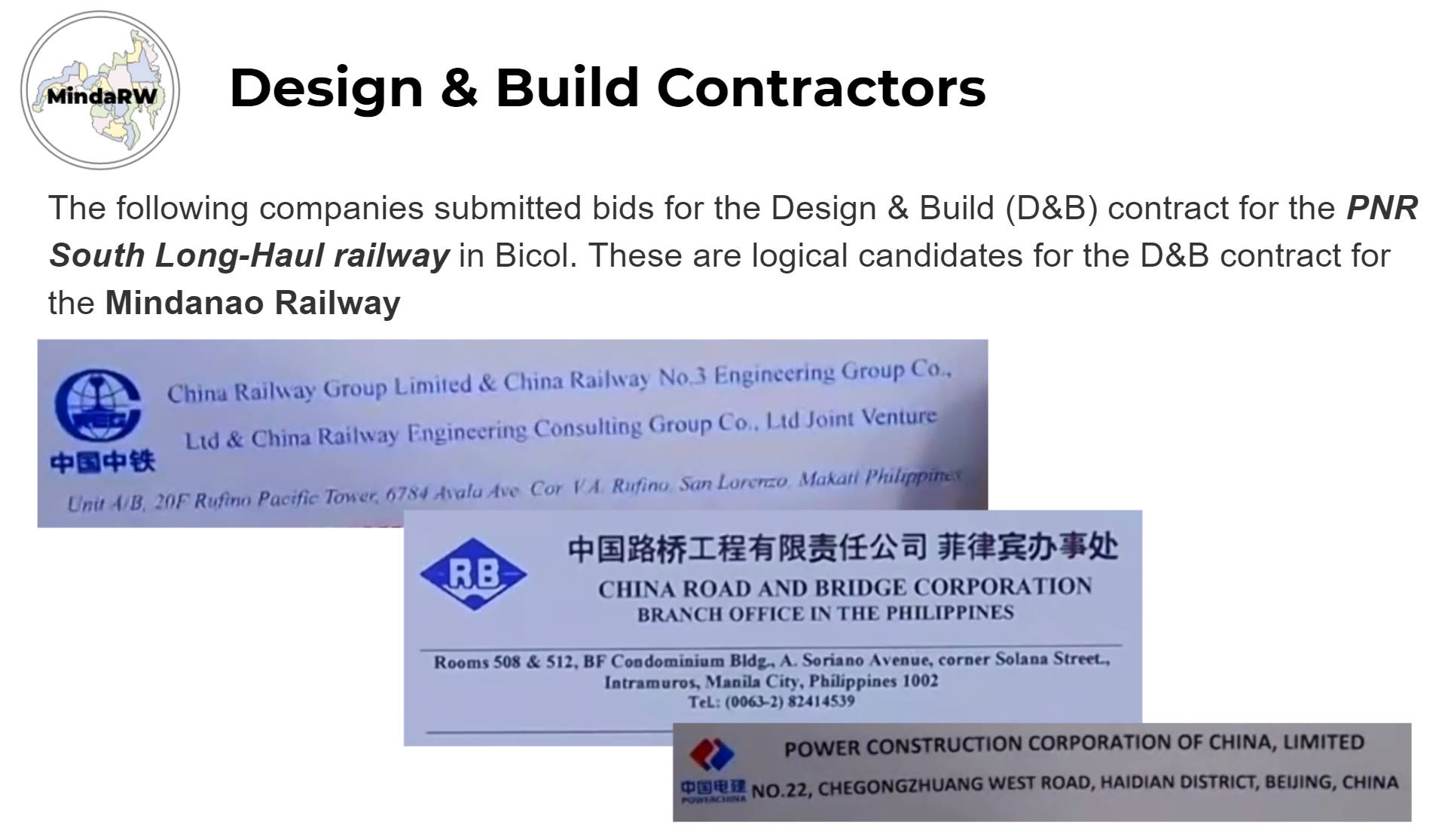
2021 4th Qtr update
On the 17th of November, 2021, the Department of Budget & Management declared that the consortium of China Railway Group Ltd, China Railway No. 3 Engineering Group Co., LTd and China Railway Engineering Consulting Group Co. Ltd were the Single Calculated Responsive Bid for the Design & Build Contract for the PNR South Long-Haul Project. The announcement appears below.
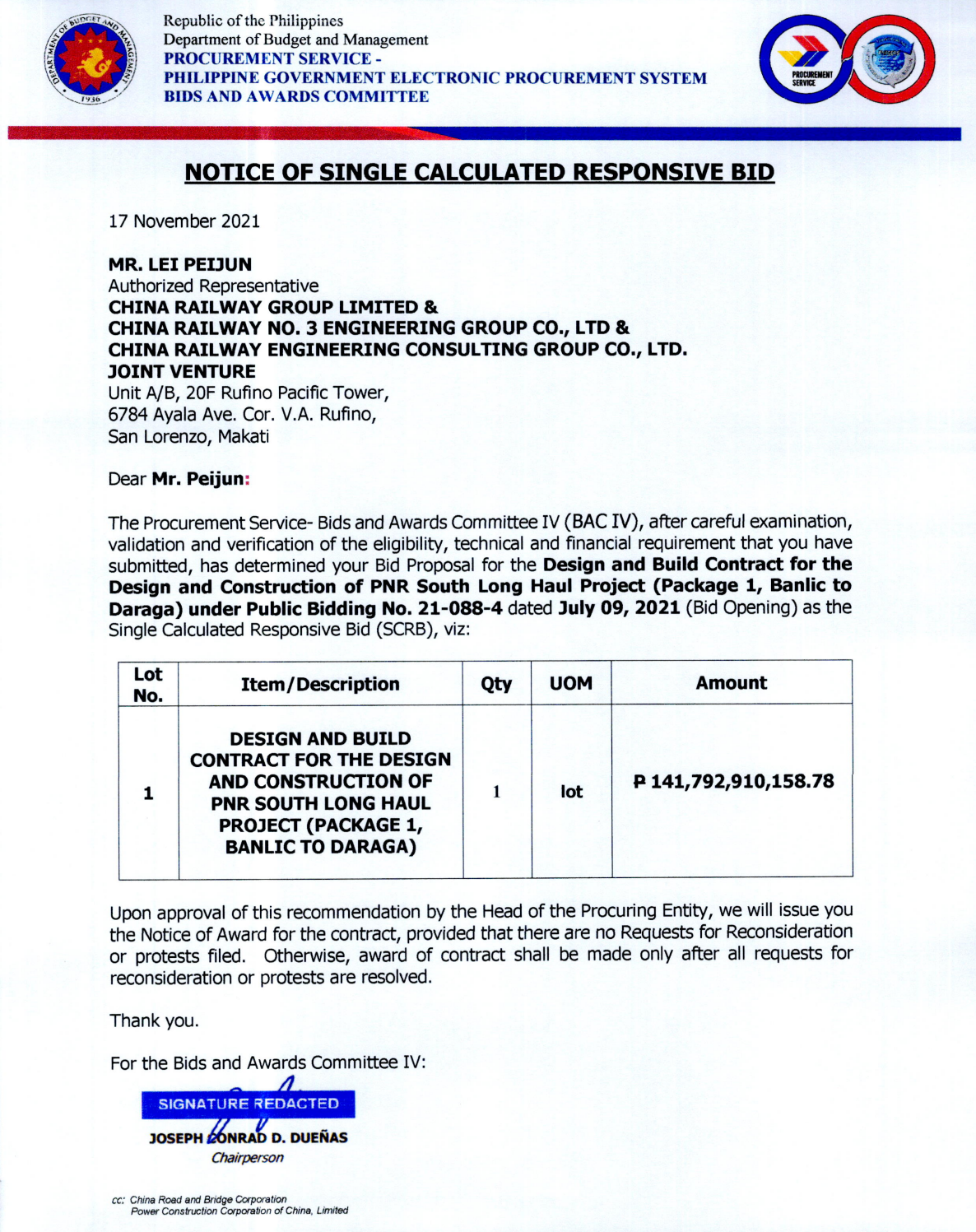
On the 2nd of December, the official Notice of Award was issued.
